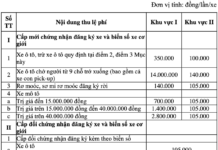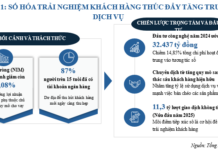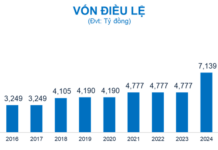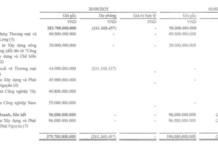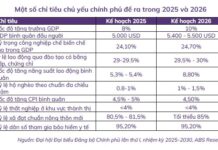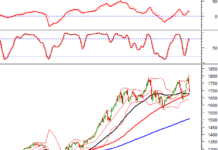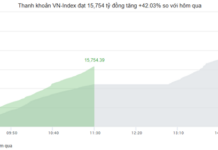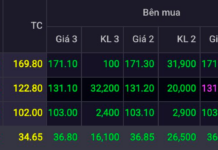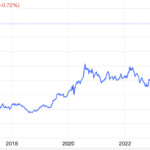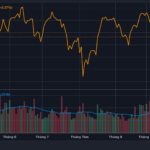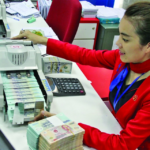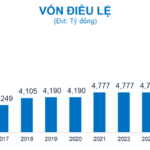The recent inflation reports in the US indicate that the Fed is close to achieving its 2% inflation target. Goldman Sachs predicted that when the Bureau of Economic Analysis (BEA) releases the monthly Personal Consumption Expenditures (PCE) price index report for October 2024, the data will be low enough to round down to 2%.
Inflation is a tricky phenomenon that cannot be fully captured by a single measure, and many inflation parameters remain much higher than what most Americans and even many Fed officials feel comfortable with. Like some of her colleagues at the world’s most powerful central bank, Mary Daly, President of the San Francisco Fed, recently provided a positive assessment of the downward trend in inflation but noted that the Fed has not declared victory in this battle and does not want to be complacent.
INFLATION COULD SPIKE AGAIN
“The process of bringing inflation down to our target is not assured. So we need to be vigilant and purposeful in our actions,” said Daly at an event hosted by the Stern School of Business, New York University.
Daly began her speech by recounting a recent encounter while taking a walk near her home. A young man with a shopping cart spoke up when he saw her: “Chair Daly, are you about to declare victory over inflation?” In response, the monetary policymaker affirmed that she had no intention of celebrating victory when it came to inflation.
This brief exchange encapsulates a dilemma for the Fed: if inflation is decelerating, why are interest rates still so high? Conversely, if inflation hasn’t subsided, why is the Fed lowering rates?
In Daly’s view, the Fed’s decision to cut rates by half a percentage point in September 2024 was an effort to pursue a “getting-it-right” policy, ensuring that the interest rate environment aligns with the decelerating inflation rate, which has declined significantly from its mid-2022 peak, along with signs of a weakening job market.
The young man’s question in Daly’s story speaks to the challenge of convincing American consumers that inflation is abating. There are two issues when discussing inflation in the US today: first, the annual inflation rate; and second, the cumulative effect of inflation on the economy after three years of high inflation.
The 12-month inflation rate only provides a narrow glimpse of the inflation landscape. In September 2024, the year-over-year increase in the Consumer Price Index (CPI) in the US was 2.4%, a significant improvement from the peak of 9.1% in June 2022. While CPI attracts public attention, it plays a secondary role for the Fed, which relies more on the PCE index to assess the inflation situation. Using the CPI inputs to estimate September 2024 PCE, Goldman Sachs concluded that the September PCE would be just a tad above the Fed’s 2% inflation target.
Inflation in the US first surpassed the 2% target in March 2021, and for many months, Fed officials considered it a “transitory” product of pandemic-related peculiar factors that would soon fade away.
In reality, inflation was not transitory, and the US CPI has increased by a total of 18.8% since then. Food prices have risen by 22%, egg prices by 87%, auto insurance by nearly 47%, and gasoline (despite recent declines) by 16%. Regarding housing: the average US home price has increased by 16% since Q1 2021 and by 30% since the start of the pandemic-era home-buying frenzy.
Furthermore, while broad measures like CPI and PCE are declining, other measures indicate the stubbornness of inflation. For instance, the Atlanta Fed’s “sticky price” inflation measure (which includes goods and services like rent, insurance, and healthcare) remained at 4% in September 2024, even as the “flexible CPI” (including food, energy, and vehicles) fell 2.1%. This suggests that the prices of less flexible goods and services remain high, while more flexible ones, like gasoline, are declining but could easily reverse course.
Another inflation measure, core inflation (which excludes volatile food and energy items), stood at 3.3% in September 2024 for CPI and 2.7% in August 2024 for PCE.
While Fed officials have recently emphasized the overall inflation measures, history shows they consider core inflation a more accurate gauge of long-term trends. This makes it understandable why the Fed hasn’t declared victory over inflation yet.
DEBT CONCERNS
Before the surge in inflation in 2021, US consumers were accustomed to negligible inflation for many years. But even as inflation soared, they continued to spend, even spending more, all the while complaining about rising living costs.
According to BEA data, in Q2 2024, annual consumer spending in the US reached nearly $20 trillion. In September 2024, US retail sales rose 0.4%, a higher-than-expected increase. However, spending compared to the previous year only increased by 1.7%, lower than the 2.4% CPI increase.
Much of this spending by Americans is funded by various forms of debt. Fed data shows that total household debt in the US reached $20.2 trillion in Q2 2024, an increase of $3.25 trillion, or 19%, since the start of the inflation surge in Q1 2021. In Q2 2024, household debt increased by 3.2% year-over-year, the largest increase since Q3 2022.
Thus far, the rising debt levels of US households have not been a significant problem, but that may change. The delinquency rate on consumer debt in the US is currently 2.74%, the highest in nearly 12 years, although still slightly below the long-term average of about 3%, according to Fed data going back to 1987. However, a recent New York Fed survey found that the percentage of respondents who said they were likely to be delinquent on their debt in the next three months jumped to 14.2%, the highest since April 2020.
It’s not just consumers who are using credit cards more. Small business credit card usage in the US is also on the rise and is now up more than 20% from pre-pandemic levels, nearing a 10-year high, according to data from Bank of America (BofA). BofA economists predict that debt pressure will ease as the Fed cuts rates, but the pace of rate cuts could be an issue if inflation persists.
In fact, one bright spot in this picture is that small business credit card debt has increased less than the 23% inflation rate since 2019. However, the sentiment among small businesses is deteriorating. A September 2024 survey by the National Federation of Independent Businesses (NFIB) found that 23% of respondents still considered inflation their biggest problem. This means that inflation is also the biggest challenge facing NFIB member businesses.
THE FED’S DILEMMA
With a mix of positive and negative inflation data, the Fed’s interest rate decision at its monetary policy meeting on November 6-7, 2024, will be crucial. Since the Fed’s half-point rate cut in September 2024, the market has reacted curiously. Instead of reflecting expectations of lower rates in the future, investors have started to reflect higher rate expectations…
https://postenp.phaha.vn/chi-tiet-toa-soan/tap-chi-kinh-te-viet-nam
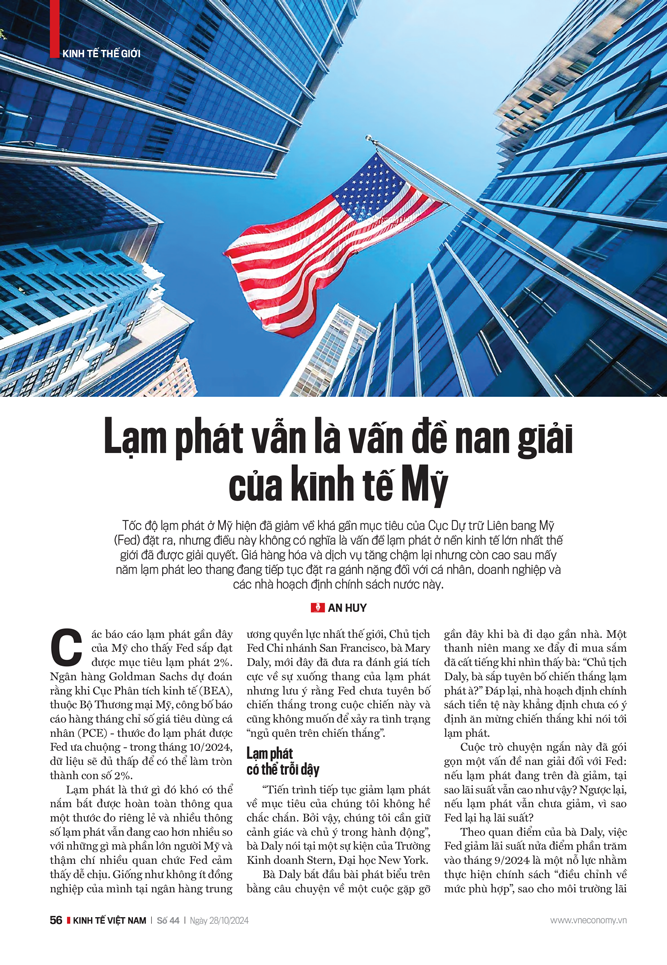
“Steady Credit Growth, VPBank’s 9-Month Profit Surges 67% Year-on-Year”
As of the third quarter of 2024, VPBank has recorded a remarkable performance with a consolidated pre-tax profit increase of over 67% year-on-year, thanks to the contributions of its comprehensive ecosystem. The bank has maintained stable credit growth, enhanced debt recovery activities, and continued to tightly control asset quality.
Capital Injection for Year-End Business Boost
The banking sector is gearing up for the festive season with a plethora of loan offerings tailored for businesses and merchants. As the year draws to a close, financial institutions are rolling out attractive loan packages with a variety of incentives to support enterprises in their endeavor to meet the surging demand during this peak season.
The Dollar’s Surge: A Cause for Concern?
Since the beginning of October, commercial bank USD rates have increased by approximately 730 VND, a significant rise in under a month.





